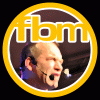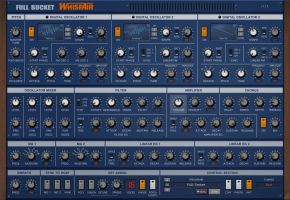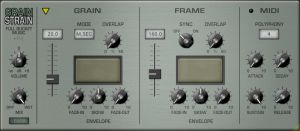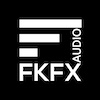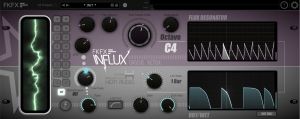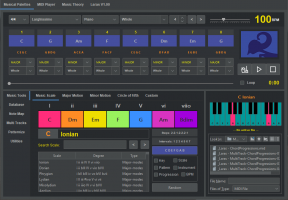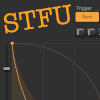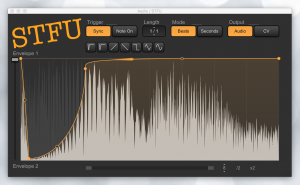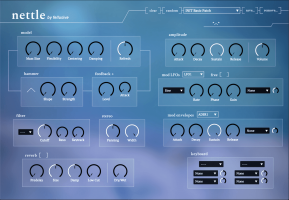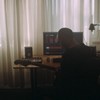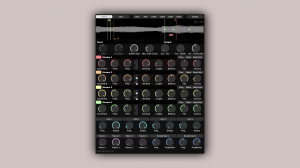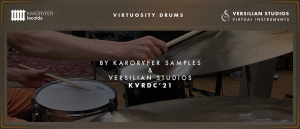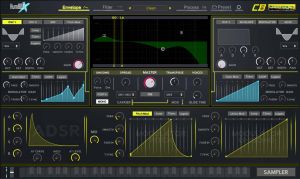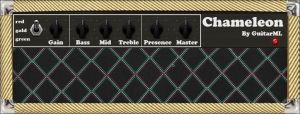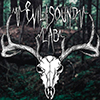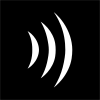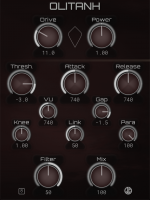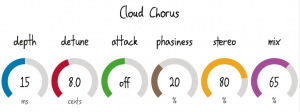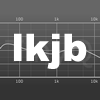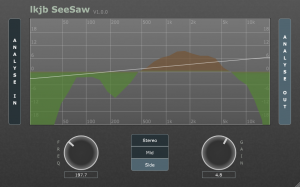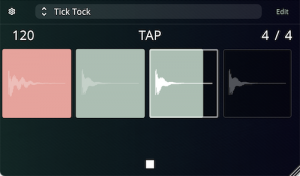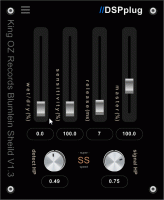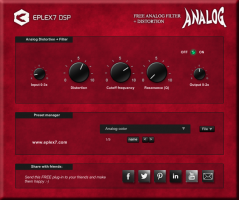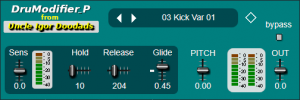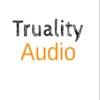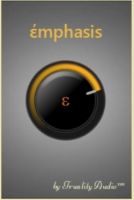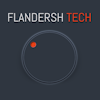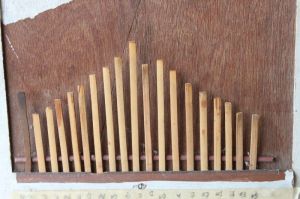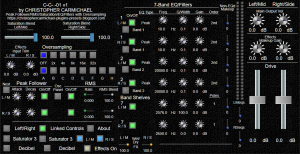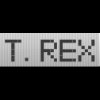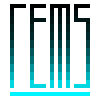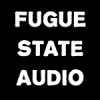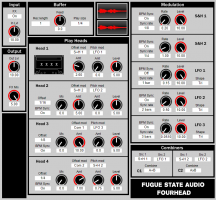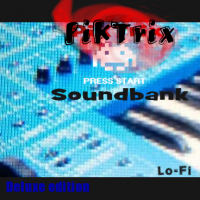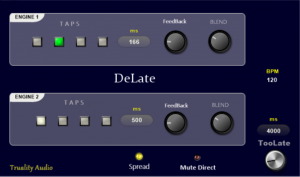
KVR Developer Challenge 2021
KVRDC21 Prize Fund
$4,000.00
Donations Closed
See You Next Time!
Voting is CLOSED! The winners have been announced here (FYI they are listed below in the order they finished - the winner at the top). Thank you and congratulations to everyone!
Welcome to the KVR Developer Challenge 2021, the eighth free-for-all audio plugin / audio application / soundware design event.
The "KVR Developer Challenge" is for anyone who develops Audio Plugins or Applications and Soundware. The challenge is to create and release a brand new free audio plugin, application or sound library / pack / set that will benefit the community at large.
Creativity is key, it can be as simple or as complex as you want - KVR members will vote on the entries and pick the eventual winner using whatever criteria they choose to.
Five cash prizes will be awarded to the top entries and a wildcard pick. Prize moneys are sponsored by the community-funded KVR Developer Challenge 2021 donation pool.
The KVR Developer Challenge began in 2006 and has occurred every 2-3 years ever since. It's delivered gems such as ProF.E.T. by Ignite Amps, Deducktion by Dead Duck Software and MPS by Full Bucket Music back in 2018, Youlean Loudness Meter, Lagrange by Ursa DSP and Spaceship Delay from Musical Entropy in 2016, Multiply by Acon Digital, Nova-67P by vladg/sound and Emissary by Ignite Amps in 2014, and so it goes on...
Check out 2012, 2009, 2007, and the original in 2006 when Triple Cheese by u-he won the show!
Discuss in the dedicated KVR Developer Challenge forum
KVR Developer Challenge 2021 Entries
All
Entries
37
Plugin / App
35
Plugin / App
20
Plugin / App
7
Plugin / App
1
Plugin / App
1
Soundware
3
| 5 Points: | - |
| 4 Points: | - |
| 3 Points: | - |
| 2 Points: | - |
| 1 Points: | - |
Voting is now closed!
You can vote for your favourite 5 entries.
Award 5 points to your favourite, four to your second favourite, down to 1.
Votes are saved automatically. You can change them at any time until voting closes - simply click the appropriate number next to the entry you are voting for and your votes will be updated in this "My Current Votes" box.
WhispAir is a software instrument for Microsoft Windows (VST2/VST3/CLAP) and Apple macOS (VST2/VST3/CLAP/AU). It is written in native C++ code for high performance and low CPU consumption.
Main features:
- All parameters on one single page.
- Three flexible wavetable oscillators.
- Classic Full Bucket stereo filter.
- Three modulation and four envelope generators.
- Unison mode and Chorus.
- TUN/SCL/KBL micro-tuning file import.
- Supports MTS-ESP by ODDSound dynamic micro-tuning.
- Resizable user interface (not "N" version.).
- MIDI Learn – all parameters can be controlled by MIDI CC.
- Plug-in supports Windows and macOS (32-bit and 64-bit).
GR-8 is an 8 voices virtual analog synthesizer with built-in effects and an arpeggiator.
Features:
- Arpeggiator: 5 Modes (Up, Down, Alt 1, Alt 2, Random), 4 Octaves Range.
- Voice Modes: Mono, Unison (8 voices), Chord (4 stereo notes), Poly (8 voices).
- Voice Effects: Glide, Legato, Voice Detune, Voice Stereo Spread.
- Oscillators: OSC 1 (Tri, Saw, Pulse, Square), OSC 2 (Sine, Saw, Pulse, Noise).
- Oscillator Effects: Cross Modulation (FM), Pulse Width Modulation (PWM), Sync.
- Filters: Non-resonant High Pass, Resonant Low Pass (12, 18, or 24 dB/Octave).
- Modulation: Pitch Bender, Mod Wheel, LFO, 2 Envelopes.
- Effects: EQ, Distortion, Phaser, Chorus/Flanger, Delay, Reverb.
- Presets: 88.
Important: Parameter automation IDs are changed in version 1.2.0. That breaks automation compatibility with previous versions. If you open an old song that had automated (for instance) Filter Cutoff, that automation lane will now automate some other parameter i.e. Envelope Attack. The change is a fix for a mistake that I made by adding new controls in versions 1.1.0 and 1.1.1. Due to my inexperience with newer versions of the plugin development platform that I use, I didn't know automation parameter IDs are automatically set in alphabetical order unless manually specified. My sincerest apologies to everyone whose work is affected by the change. On the brighter side, presets are not affected by this change, so your old presets will sound the same as before.
Caution: Each preset has its own MIDI assignment. If you make a MIDI assignment you need to save the preset. Otherwise, the MIDI assignment you've made will be lost as soon you change the preset. If you want to make your own presets with the same MIDI assignments, you can do it by assigning MIDI controls to the Initial preset, saving a copy of it, and using it as a template for your sounds.
Change Log.
v1.2.0 - 2021-10-08:
- Assigned Parameter Automation IDs (breaks automation compatibility with previous versions).
- Removed MIDI Assignments from presets.
- Simplified installation for Mac (one installer for plugin and presets).
v1.1.1 - 2021-09-25:
- Added global Octave control (+/- 2 Octaves) (per request).
v1.1.0 - 2021-09-22:
- Added version number to the GUI.
- Added Synth/Effects Randomize and Reset functions (per request).
- Changed Arp controls to drop-down menus (per request).
- Fixed popup hint text for all switches.
- Removed random phase from Oscillators in Mono and Poly modes.
- Moved Pitch Bender and Mod Wheel controls above the wheels.
- Added Pitch Transpose control (+/- 6 semitones) (per request).
- Added Velocity to Filter Cutoff and Amplitude (per request).
- Optimized LFOs to save CPU.
- Added LFO Retrig button - this will affect some old presets (per request).
- Added internal ON/OFF switches to Chorus, Delay & Reverb to save CPU.
- Preset List returns to top on a Category change.
- Improved Preset List scrollbar motion.
- Updated GUI and About screen.
v1.0.7 - 2021-07-27:
- Fixed silent presets caused by the Phaser module.
v1.0.6 - 2021-07-24:
- Fixed DC offset caused by the Phaser module.
- Updated About screen.
v1.0.5 - 2021-07-24:
- Fixed arpeggiator.
v1.0.4 - 2021-07-22:
- Replaced arpeggiator module with a newer module.
- Updated About screen.
v1.0.3 - 2021-07-19:
- Replaced arpeggiator module.
v1.0.2 - 2021-07-18:
- Fixed wrong pitch caused by switching from Mono to Poly mode.
- Various fixes to prevent excessive use of CPU.
- Removed diffusion from Delay to reduce CPU usage.
- Removed oversampling to reduce CPU usage.
- Doubled Filter Env Depth range.
- Assigned MIDI CCs to Init preset.
- Enabled custom installation folder on PC.
- Added manual installation option for plugins and presets on PC.
- Added manual installation option for presets on Mac.
v1.0.1 - 2021-07-04:
- Fixed silent Saturation mode on Distortion. All the presets using it were silent too.
- Fixed Pitch Bender returning to zero when controlled via MIDI.
- Updated About screen.
Grain Strain is a software effect plug-in for Microsoft Windows (VST2/VST3/CLAP) and Apple macOS (VST2/VST3/AU/CLAP). It is written in native C++ code for high performance and low CPU consumption.
Main features:
- Flexible grain looping with Sync-to-Host options.
- Envelopes for both grains and loop iterations (frames).
- "Grain Vocoder":
Grain frequency control via MIDI (up to eight voices). - Supports MTS-ESP by ODDSound dynamic micro-tuning.
-
Resizable user interface (not "N" version.).
- MIDI Learn – all parameters can be controlled by MIDI CC.
- Plug-in supports Windows and macOS (32-bit and 64-bit).
by FKFX Audio
Influx is an instant "Sonic Retox" engine. The resonator module (FLUX) goes thru a Low Pass and a Tube distortion. Flux resonator Note and Dry/Wet have their dedicated editors.
Influx lets you create new grooves from your current input. Selecting "WET ONLY" will output only the transformed part of the signal.
Influx comes with 210 Factory preset.
Features:
- KVR WILDCARD AWARD.
- Flux Resonator: multi-point LFO Editor on resonator note.
- Flux Chaos: Resonator realtime re-fuel with audio input.
- Flux Center Note: Select the root note for the Flux Resonator with optional MIDI control.
- Flux Scale Snap with 38 automatic scale modes.
- Flux Stereo: adds stereo pitch shift between left and right Flux Resonator.
- Flux LFO: controls Low Pass Filter.
- LFO Rate: From 4 Bars to 16th, with polyrhythmic rate (i.e. 5th, 7th).
- Low Pass Filter: can be controlled with Flux Resonator LFO.
- 16 Waveshapers.
- Tube Distortion.
- Low Cut Filter: Remove low rumble from signal.
- Gain: Sets post distortion gain, 48dB/+48dB, exponential.
- Dry/Wet Maximum.
- Dry/Wet LFO Editor.
- WET ONLY switch: get only the resonator wet signal.
- FULL WET button, with extra strike animation.
- Editor Tools: Smooth, Normalize, Flip, Chop, Roll, Pencils, snap modes, etc..
- Editor Modes: Point edit mode, and a global Select Mode.
- Preferences: OpenGL animations, MIDI Note, MIDI Thru.
- Vumeters: Input and Output Vu Meter.
- Preset Manager.
- Preset Locking option: Locks part of the plugin, so to stay unchanged on preset load.
- 210 Presets.
by Heri H. Hasyim
LARAS (means Music Scale in Javanese language), is a free (and soon to be open source) tool that can be used as:
- Music composition tool.
- Music scale learning tool.
- Major/minor motion composition learning tool.
- Circle of 5th based composition learning tool.
- Music learning/teaching tool.
- Musical "typewriter".
- Chord generator/chorder.
- Fingering for Keyboard, Guitar and Ukulele learning tool.
- Database of chord progressions.
- .... or just another tool to waste your time with 175 scales, 74 chord types, more than 500 common progression, 100 free form progressions, progressions from 1,000 songs (many of them share the same chord progression off-course) using more than 1,200 playing patterns.
LARAS is developed using Java Development Kit, Apache NetBeans and JFugue, an open source programming library to program music in the Java programming language by David Koelle.
The third tab of Music Theory in the main area of the program is intended to be placeholder for information on basic music theory. This Music Theory section has nothing to do with the functionality of the program, as it will contain only information on music theory.
To run use LARAS you need to have Java Runtime Environment (JRE) in your system.
To install, just unzip the downloaded file and follow the instructions in the README.TXT in getting and installing the required Java Runtime Environment for your system.
At this time, LARAS does not yet provide dedicated installer, it is intentional to make the process of setting LARAS across OS is similar:
- Download LARAS.
- Download and install JRE, if you don't have it on your system.
- Extract LARAS to a folder.
- Run LARAS from that folder.
Happy Composing...
Version History
July 1, 2021
V1 - First Release.
July 6, 2021
V1.01 - Bug Fix:
- Fix three chords that can't be used in the first release (Majb5, Maj7#9, C7#9).
- Fix Track 4 error in the Multi Tracks Composition. In the previous version if you use Track 4 for other than Drums then Track 4 and 3 will be merged.
- Fix definition error in STY Blues Bass patterns.
- Fix transpose button in the Music Scale that leads to putting wrong notes in the scale notes information and in the scale MIDI file.
- Fixing typos in the user guide.
July 8, 2021
V 1.02 - Bug Fix:
- Revise Scales.dat
- Change 6 chord to maj6 chord
There is no 6 chord in LARAS, as 6 and maj6 chord is the same
Some entries were missed during cleaning of Scales.dat when released. - Change m7#5 chord to m7 chord
There is still problem in transferring chords that have sharp or flat in its name
for example m7#5, maj7b5 etc from text database (.dat file) to chord slots
But these chords are fine if they are selected from chord banks or drop down menu
The problem is related to Java and Unicode for sharp and flat. - Fix any typos.
- Change 6 chord to maj6 chord
- Revise FreeFormProgressions.dat and CommonProgression.dat
- Change one entry that has m7b5 to m7
The reason is similar with Scales.dat and m7#5 case above.
- Change one entry that has m7b5 to m7
- Revise Songs.dat and CommonProgressions.dat
- Fix any typos.
- Change 6 chord to maj6 chord.
- Change font in Temporary Notes so it will show Unicode of sharp and flat correctly.
- Adding information in the user guide on typing user own chord progression that use flat and sharp.
- Edit Tab Name to make How to Use section more obvious to user.
Make your audio STFU.
STFU is a super quick to use sidechainer that can be automatically sync'd to host BPM or triggered by MIDI and it's always sample accurate. Using MIDI trigger, you can overcome limitations of synth volume envelopes for a myriad of purposes.
STFU can also output CV for use with lots of hosts and modular plugins.
And crossfade between 2 different envelopes for all sorts of cool stuff.
Nettle is a software instrument that explores the unique and relatively under-explored world of scanned synthesis. The timbre of the sounds you create constantly evolve, as the waveform produced is made by tracing (scanning) the positions of masses that are always in motion. These masses are set into motion when you press a key on your MIDI controller - this simulates the action of a hammer striking the connection of masses. Through the user's manipulation of the masses, the springs that connect them, and the hammer that excites them, a wide range of dynamic, almost sentient, sounds are possible.
Features include:
- 32-voice polyphony.
- Fully automatable knobs.
- Filter (low-pass, high-pass) and reverb available for signal processing.
- Four LFOs and ADSRs available for modulation, along with two sources for modulation via your MIDI controller.
- Built-in presets, as well as the ability for users to save and modify their own presets.
- A randomize button.
Nettle can be downloaded from my website as well as via KVR. Please feel free to contact me for any questions and feedback.
Emergence occurs when an entity is observed to have properties its parts do not have on their own, properties or behaviors which emerge only when the parts interact in a wider whole.
This plugin is a real-time granulator. It continuously records the input signal into a buffer. The content of the buffer is played back as many short pieces of sound called grains. Up to 600 grains can be generated in 4 streams, each having it's own set of parameters that control grain generation.
A single grain is not that interesting. The most exciting things happen when hundreds of overlapping grains play together, creating anything from complex delay patterns to strange noises to beautiful layered soundscapes.
Features:
- Up to 600 grains (depending on your CPU).
- 4 grain generation streams with independent parameters.
- Modulation system with LFOs, Macros and parameter randomization.
- High quality grain pitch transposition (+/- 24 semitones).
- Freeze buffer contents.
- Built-in help (hover over controls and see text at the bottom).
- Resizable UI.
- VST3 and AU format available.
If you like the plugin you can support my work on Patreon or itch.io.
Dead Duck Reducktion is a 32-voice polyphonic software synthesizer for use in audio hosts that support the VST 2.4 plugin format. It available for Windows operating systems in both 32-bit and 64-bit versions.
Features
Three multi-mode oscillators:
- Wave: continuously variable between saw, square, triangle and sine waveforms.
- Pulse: pulse wave with variable width from 0 to 100%.
- FM: sine wave FM with carrier and two modulators.
Full stereo output with oscillator pan and stereo noise options.
Up to 8-voice unison detune with mix and stereo spread controls.
Two resonant filters:
- 24 dB/oct low pass with self-oscillation.
- 12 db/oct low pass, high pass, band pass, band stop and peaking.
- Serial, parallel and split routing modes.
Three ADSR envelopes.
Three flexible LFOs:
- Triangle, sine, square, saw and random outputs.
- Tempo-sync, free-running, phase and attack time.
A 12-slot modulation matrix.
Built in drive, EQ, chorus, delay and reverb effects.
16-step arpeggiator/sequencer:
- Up, down and up/down arpeggiator modes.
- Sequencer-controlled note, velocity and note length.
- Variable step count and tempo-based step times from 1/32T to 1/1D.
- Two modulation sources with stepped or smoothed output options.
MIDI learn for easy assignment of hardware controllers.
File-based preset system for easy management and sharing.
Resizeable user interface with a range of scaling options from 100% to 200%.
User-definable themes for easy customisation.
Installation
Reducktion is provided as a simple zip-file package; for a quick and easy installation simply extract the contents to a plugin folder that is write-accessible by your host.
For more detailed setup instructions see the online User Guide.
by Versilian Studios
Virtuosity Drums is an open source (Creative Commons 0) contemporary Jazz drum kit library, performed with sticks, recorded at Virtuosity Musical Instruments in Boston, MA. It features performances by drummer Austin McMahon on the shop's "house kit", indicative of a typical setup in a live club or venue, recorded in the style of a live recording. The library is available in SFZ format and designed specifically to work in Sforzando and ARIA Player.
The snare, toms, and kick were recorded with a 'wave' technique, where rather than attempting to record discrete dynamic levels, the drummer freely played louder and softer notes in a series of dynamic swells which were then cut and sorted. The result is up to 36 dynamic levels with no round robins, which makes these instruments very suitable to live playing on keyboard or virtual drums as they will benefit enormously from the natural variation in velocity. The cymbals on the other hand use a smaller number of discrete velocity layers at 4 round robins, to help in situations of high repetition.
Also included are a range of Latin percussion and traps drawn from the VSCO 2 project, making the library almost fully GM-compliant. The full kit patch includes several additional articulations such as partially and fully muted snare, several steps of semi-open hi-hat, and snare buzzes, roll, and flams:
- 1,000 unique samples [per mic position]; 4,900 total sample files.
- 1.5 GB total size with 48kHz/24-bit samples and FLAC (lossless) compression.
- 6 mixable microphone positions: Kick, Snare, OH, Mid (stereo ribbon), Room, and Vintage.
- Runs in the free Sforzando player by Plogue, simply drag and drop the 'Virtuosity Drums.bank.xml' into Sforzando and it will appear as a set of options when you click 'Instruments'.
- Full snare on/off control (including for kick).
- Additional percussion from the VSCO 2 project for near-complete GM compliance.
- Extended non-GM drum techniques available for Snare, Hi-hat, and toms.
- Adaptable for electronic drums with optional hi-hat CC4 keymap.
License info:
This library (Virtuosity Drums) is released under a Creative Commons 0 (CC0) license as a corollary to the VCSL project and its core objective of creating a 'baseline' set of consistently high-quality, publicly available samples. Composers, musicians, and artists of all kinds may use this product for any purpose, commercial or not, without the need for attribution, permission, or any other roadblocks of any kind.
While we gladly welcome and encourage derivative works, we urge any derivative virtual instrument projects to consider providing attribution and notes on what changes were made, so as to maintain provenance of the samples and disambiguate your work from its roots. We also encourage derivative works to release under CC0, 'Free Culture', or similar licenses and at no cost to users, in keeping with the spirit of the samples.
Hum808X.
It is a synthesizer designed to be easy to use thanks to its all-in-one interface.
The reading of the signal is possible thanks to its spectrum analyzer and
his oscilloscope that allows us to shape the sound with great ease from both a technical and creative approach.
Its three oscillators together with the sampler can operate in subtractive or FM synthesis according to the configuration of each user, facilitating sound experimentation with unimaginable ranges., .
A quick example.
1. Load the default preset
2. On the master panel, set Carrier freq with Osc1 - Osc2 and Mod to Sampler, activate the FM button
3. Drag a swatch of a bell onto the swatch and activate it
4. Activate the Pitch Shifter with a mix of 10% in the Envelope tab
5., Adjust the modulation from -3.84 to 3.80 st in 2 steps
6. Remember to Activate the Mod Pitch and the Loop button
7. Increase the vocals, unison and spread to your liking and listen to your patch.
And to finish creating your idea you can process your sound with its 5 included effects...
Let's have fun designing something with the Hum808x.
These are its main characteristics:
- Additive Synthesis and FM.
- 3 oscillators with 5 waveforms.
- 1 sampler with 90 useful samples in FM synthesis, Keytraking, Root Note Selector.
- Maximum 16 unison voices, extended voices, portamento with slide time adjustment.
- 1 ADSR for each Generator and one global.
- Time, gain and filter modulators.
- Modulation to DAW synchronized in time.
- 16 types of filters with modulators.
- 5 effects: distortion, compression, limiter, reverb, delay.
- 1 parametric equalizer.
- 5 Zoom settings for GUI.
- Midi Learn by left clicking and moving around the buttons, knobs and pitch wheel for any MIDI controller.
- Assign left-click CC to buttons, knobs, and pitch wheel for any MIDI controller.
- Spectrum Analyzer, Oscilloscope.
- Speed response adjustment.-.
- 450 presets.
FREEWARE and OPEN SOURCE GLP3.
Freeware y código abierto (GPL3).
https://soundcloud.com/callybeat/hum808-demo2
http://soundcloud.com/callybeat/hum808x-100-music
Version history.
July 1, 2021
V1 - First version.
July 25, 2021
V1.01 -
Now available in VST3.
Bug fix:
Fix Midilearn fix on master knob
Fix Midilearn correction on Gain Osc 1 and 2 knob
Fix Midilearn correction in Gain Osc 3 controller
Fix Midilearn fix on Pitch Bend fade.
April 16, 2022.
V1.03 -
Correct at zero crossing
Fix gain knobs for all generators
New distribution in oscillators
Window for each oscillator
New preset manager
New portamento option with slide time
Now it is possible to activate all generators simultaneously
Enclosures for all generators
Pitch shifter for each oscillator
Keytracking for sampler
Define Arial as font function
Legato for all modulators
GUI redesign.
Transperc is a transient processor (shaper) created mainly for percussive material, but can be used on any type of sound.
The wet chain starts with the filter (lowpass, highpass), then come attack and sustain with the ability to adjust the speed of the detection.
The output section includes dry and wet mixer, overall gain and on the end the possibility of hard clipping.
With simple resizable GUI (click on a name/logo).
by Jade Hochschule
FilterDeMystifier (no mysteries, just math) is a filter plug-in for educational use. It will show you how a few poles and zeros define the sound of equalisers or vocal filters.
Everything is visualised and you can see the transfer function and the resulting magnitude z-plane in a rotatable 3D plot.
Check out the presets to see what can be realised with this straight-forward GUI.
Please be aware that this plug-in can generate very unpleasant sound, if the security measures are switched off.
Have fun and read the manual, if you are interested in digital signal processing.
The source-code is available at: https://github.com/ArnoSchiller/FilterDeMystifier
It started as a course work for the final exam in DAFX (Digital Audio Effects) at our University (Jade Hochschule).
A channel routing tool, multi-fx, crossover, multiband-fx, transient shaper, etc. disguised as a channel mixer. Bundles some own and some open source FX.
This is a swiss-army knife FX to complement your existing ones, helping to keep your mixes tidy. It has a lot of tricks on its sleeve. Seriously, this is not a conventional plugin.
The interface puts a lot on a single page, it is designed for fast workflow. It is vector-based and resizeable, but it will look a bit cramped on small screens.
The plugin is tested by me on REAPER, both Linux and Windows. I'm a professional developer with lots of obligations and scarce time, so I can't commit to support every available host. The same happens with Mac, I don't own a Mac. Having said that this uses JUCE, so it should work with minor modifications. Contributions are welcome and of course any contributor would have my full support.
Chameleon is a guitar plugin/standalone app using neural networks to create three distinct sounds from a vintage style amp head. The core sound comes from a neural net inference engine which allows the plugin to disguise itself as a high end tube amplifier. Advanced machine learning was used to capture three distinct sounds, named Red (high gain), Gold (crunchy), and Green (clean). In the same way a real amp head is used with a cabinet and other effects, this plugin is intended to be used in the signal chain along with IR's (cab sim), reverb, and any number of guitar effects.
Chameleon is free and open source on Github for anyone interested in audio DSP with machine learning and neural networks. The capture technique used here is capable of reproducing the dynamic response of real amps and pedals.
Check out the source code on GitHub.
Read the tech article published on Towards Data Science.
Visit the website for more from GuitarML.
Version 1.2 adds stereo processing, improved amp and EQ sound, and fixed state saving in DAW. Removed Standalone and Win32.
by Evil Sound Lab
The King is a high-gain distortion pedal based on the brand-new schematic.
Our goals were to reject conservative guitar pedal controls and to implement sound design tricks and mixing approaches in the one plug-in to give the user most flexible tweaks from guitar sound perspective. Ideally, we would be happy if you needed The King and your lovely cabinet IR only to get mixed-ready guitar sound.
We thought about hi-gain guitar sound in the mix and production, but driven from schematic designs of various studio and guitar devices. So this plug-in is an accurate math model for our frankenschema. Let me introduce you his parts:
- Destiny this way we call a pre-distortion emphasis peak filter with tunable frequency to manage the distortion structure. Actually, most of the distortion pedals have such kind of filter with some fixed specific frequency. But you could moving this knob you would find that it changes sound drastically, and it allows to get whole range from hard-grained fuzzy blues sound (on the left side of the knob) to a mellow modern rock tone (on the right one), and all variations in between. And you can play this card with The King. Also, it's possible to switch on the another one emphasis dip filter after distortion unit with the same frequency and intensity, but mirrored, and in this case you will get distortion density in selected range, but without frequency response imbalance. Play this game and choose your destiny.;
- Low and high turn these knobs counter-clockwise to get classic pedal tone lift with envelop sense OR turn clockwise for focusing tone: it enhances pleasant resonances through decreasing interfering frequencies;
- Air mimics the leakage of electric guitar strings into a condenser microphone. It may give sparkling overtones to your rhythm parts and can add articulation accents to the heaviest gain flat notes. It also has a brother - air saturation knob - just to warm the air up for a bit;
- Mid character toggle. Gives three sound options: smiley curve to get scooped rhythm guitar sound, nasal raise to 1.5 kHz which can help your solo to cut through busy mix and of course neutral tone with flat middle frequency response;
- Last not the least, two EQ knobs to help keeping muddy and harshly frequencies in line or adding warmth and presence depends on the case. See if these two guys will help you mix your guitar sound without additional equalizers in the chain, fingers crossed.
Also plug-in supports:
- some fine-tuning tweaks for features described above;
- oversampling modes to enhance the precision of signal processing;
- Mono/stereo modes;
- Input and output volume controls, etc. that's boring...
Change log:
v1.0.0 - 2021-06-30 Initial release
v1.0.1 - 2021-07-07:
- (fixed) critical crush during low/high knobs rotation with "java.lang.NullPointerException at com.evilsoundlab.aundine.engine.fx.a.a.h" message;
- (fixed) mono/stereo toggle doesn't work;
- (fixed) oversampling anti-aliasing filters worked improperly.
The King is a pure King of Distortion in your DAW right after YOU.
More - the one-knob distortion plugin with too many knobs.
More is a collection of wave digital filter-modeled distortion circuits, taken from the world of guitar, but modified for general use. Various tube amplifier gain stages are included, as well as a transistor fuzz pedal and a diode distortion circuit.
Just turn the big knob to get more.
Features:
- 5 distortion circuit modes.
- Automatically gain-compensated distortion knob.
- Adjustable lowpass and highpass filtering before and after distortion processing.
- Dry/wet and level controls to keep things reasonable.
- Electrifying audio visualizer.
More is built with iPlug 2 - check it out here.
by John Crosby Acoustics
Olitanh - Vintage Vibe Compressor.
Update:
- Make Up gain knob added by popular request;
- The effect of Mix parameter, when over 100%, is now way stronger. Adding polarity flipped Dry signal can be useful, when using Olitanh in parallel processing of a spectral band.
Olitanh - Vintage Vibe Compressor.
Distortion coupled with compressor brings interdependent wave-shaping and envelope-shaping. Controlled adding of harmonics. Level boosting and stereo enhancing.
Good for "warming up" bass instruments, guitars and vocals, or for "gluing" stereo mixes and groups.
List of parameters:
- Drive, 0-40 db of gain to Tanh curve waveshaper.
- Power, .25-4 tilts distortion curve from soft to hard.
- Threshold, -18-0 db sensitivity of the compressor from low to off.
- VU, 0-1000 peak detection response from modern to vintage.
- Attack, 0-1000 speed of gain reduction from fast to slow.
- Gap, 0-9 db offset between gain reduction and gain recovery.
- Release, 0-1000 speed of gain recovery from fast to slow.
- Knee, .25-4 response of the compressor from soft to hard.
- Link, 0-100 % linking of the compressor's LRMS channels.
- Para, 0-100 % mix of the compressor from off to full.
- Filter, 0-100 % Low Pass filtering from dark to off.
- Make; -12 to +12 db of Make Up gain.
- Mix, 0-200 % from Dry to Wet and to Solo Effect, with polarity flipped Dry signal.
- 1/8, switch between none or 8 times oversampled processing.
Principle of operation
From Left-Right stereo signal Mid and Side signals are also extracted, then each of the four channels passes through 8x Upsampler, Gain Reduction Unit, Tanh waveshaper, Level Detection Unit, Filter, Downsampler and than all four channels are mixed to Left and Right output.
Set the desired amount of peak limiting, harmonic generation or distortion (Drive). Change type of the distortion (Power). Control the distortion of loud notes (Threshold). Control the responsiveness of the compressor (Attack, Release, VU, Gap, Knee and Para). Enhance stereo image (Link). Darken the distorted part of the signal (Filter). Move Mix knob towards 0% in order to lessen the effect, to bring back some original dynamics or just to compare with the input signal. Move Mix knob to 150% in order to strengthen the effect and ease settings of the parameters. Mix 200% can be useful in parallel chains of processors, but in most cases Mix should be at 100%.
The story behind
Olitanh was made using iPlug2 C++ framework, and it evolved from Oli Larkin's Oversampling Example. At first, it was just an exercise of adapting it from Mono to multichannel LRMS Stereo, but as I started to like its softness and was using it more and more in my daily productions, it deserved an upgrade. Power knob to bend the soft knee of Tanh curve. Filter knob to tame the highest harmonics and further decrease aliasing. The Compressor story. When I was excited about how versatile Olitanh became, it occurred to me that this would be just the right type of waveshaper to answer the common question: "Should I plug distortion after compressor or before?" As both answers have its own merits and its own flaws, the best of both worlds brings Olitanh - feedback compressor - where Compressor's Level Detection Unit monitors Distortion's output, but Compressor's Gain Reduction Unit reduces Distortion's input. Interdependent play of wave-shaping and envelope-shaping.
by Noizebox Industries
NB01 - distortion/sustainer is the first plugin from Noizebox Industries. Made for KVR DC21.
Inspired by a circuit from an ancient guitar pedal that was originally intended as a soft-distortion-sustainer for guitars. Giving that singing sustain without a lot of harsh distortion. This is a modern take on the same circuit, not a straight up clone, more of a work-alike inspired by the original circuit. Though a fair amount of work has gone into modelling the peculiar anomalies of an overdriven, asymmetrically clipping, amplifier circuit with a FET-based feedback loop that works like a crude compressor, prone to overcompensating.
NB01 adds control over the amount of compression applied and the response time. It its fastest setting it is not really a compressor as it starts altering the waveform of the incoming sound. It also add tone controls for more versatility in shaping the sound. The tone controls are a mix of pre and post filtering that makes them interact with the overdriven amplifier circuit in interesting ways.
The signal chain is processed with 4x times oversampling with high quality elliptical downsampling filters to limit aliasing and accurate modelling. Real time parameter smoothing for glitch-free operation. Written in native C++ for performance and small footprint. Hardware accelerated, vector based UI.
Use it as overdrive before a guitar amp plugin for a sweet, compressed and singing tone. Preferably with a bit of midrange boost to cut through. It's is also perfect for destroying drum loops. Either by rolling off the bass and making the compressor slam the transients.
Or by cranking up the low end for really making the compressor duck like crazy on the kicks, by setting the response time to moderately fast, you can tweak the gain knob to find a sweetspot where the bass triggers the compression in just the right way.
Or try it on any other material, lofi vocals, adding grime to basslines or any other creative ways of destroying sounds.
Controls:
- Gain: Sets the gain of the circuit, higher values produce more distortion.
- Compression amount: Sets the amount of compression applied. There's a lot of range here. At extreme settings the compression will be negative, i.e. a 3 dB volume increase will result in more than 3 dB gain reduction. This can cause a bubbling/pumping/grinding artefacts at some combinations of high reaction speed and high compression when the circuit switches back and forth between overcompensation. This is not a bug, it's a feature and lot's of weird distortions can be discovered here.
- Compression Speed: Sets the reaction time of the compressor feedback, higher values create more distortion as the compressor starts to chew on the waveform rather that the envelope of the sound.
- Stereo: This switches between Fully independent stereo processing, stereo processing with linked compressors and mono processing.
- Tone: lo, mid, high: Tone controls are fairly straight forward. All controls at 12 o clock means a reasonably flat response. Tone controls are also a combination of pre and post clipping, which creates more interesting textures.
- Scope: Just for amusement really. but it's fun to watch.
- Master level: Sets the output volume for balancing the mix.
A thick ensemble chorus, with a multi-stage design producing a dense cloud of echoes, giving you a smooth detuning even at extreme settings.
The phasiness control lets you slide between two detuning modes. Blending these together gives a rich and lively sound (particularly for low frequencies) - or try higher values for something less conventional.
The attack control uses envelope-followers to reduce or boost the detuning when an attack is detected. Give your attacks a little extra twang, or keep them clean and clear.
Depth and detuning are controlled independently - and because Cloud Chorus has dense echoes, depth goes up to 100ms for something between a diffuse slap-back and a small (detuned) room.
Solina2K is physical modeling based Solina strings ensemble emulation that uses 8 independent oscillators, each with its own synthesis section. Solina2K has also 2 different MIDI velocity options, a user friendly global hipass-lopass filter, a full section of built in effects (saturation, chorus, phaser, tremolo, reverb and delay), built-in draw-bars system, advanced mono mode, keyboard split option with hi-lo-both zones for both the upper and the bass sections, full automation and unique gleam effect per section (upper and bass). The sections can also get routed into any of the the effects separately.
SeeSaw is a flat-curve Tilt EQ where only the pivot frequency and max gain can be set. Its purpose is to help balancing a track or mix. On stereo tracks it also allows to only process the mid or side signal instead of full stereo.
An analyser which can be switched between input and output helps finding the correct parameters. The analyser is independent of the signal's level and only shows the spectral distribution. When used in mid or side mode it will show the according signal's spectrum.
The plugin uses JUCE with its personal license due to which a splash screen is shown when the plugin is first loaded.
Changelog:
- Version 1.0.1: Fixed frequency response curve not being updated correctly after changes where made.
TICK is a self-contained metronome. It runs almost anywhere. It runs as a plug-in, it runs on your phone. Everything is self-contained so your metronome sounds (and your BPM/time-signature) can go wherever you go.
Features:
- Sample-Accurate Metronome.
- Customizable - You choose exactly how your metronome sounds. Including ability to do basic edits within Tick.
- Portable - Tick is self-contained. As a plug-in, your audio samples are saved in the preset that is part of your audio session/project.
- Low Pass Filter - avoid bleeds while recording.
- Cross-Platform - Tick is available as an audio plug-in or a standalone app for Mac, Windows & iOS. Linux & Android (coming soon).
- Open-Source - Tick is fully open-sourced so anyone can contribute.
- Open-Standards - Tick preset format is a zip archive with plain WAVE files (containing metadata) along a simple readable XML.
- Ableton Link (iOS only).
- AUv3 (iOS only).
Source Code Available at: github.com/talaviram/TICK
Demo video: https://www.youtube.com/watch?v=mws5L_GKU9E
https://youtube.com/shorts/QTQvtyemgzs
Changelog Available at:
by DSPplug
The Blumlein Shield uses mid / side and some really classic, pleasing things to get rid of background noise. But what it does not do is use AI.
I was inspired by RTX voice that took a different approach, because I had realized that RTX Voice requires that you be close to the microphone. This means in essence, keeping the sound somewhat true to how it sounded originally was the focus.
In the case of the popular RN noise, most often it will amplify the high register, making mouth noises and breathing all too audible. While this tact means that you can be further away from the microphone and still be heard; it also bears the aforementioned hindrance.
Using the Blumlein shield after the rnnoise plug-in would seem to the most advantageous, because it means that you can rely on rnnoise's object orientated programming to make a signal further away seem closer and then also you can use the Blumlein shield to get rid of the room noise and some extra unwanted artifacts left from RNnoise after that process.
Given the fact that the Blumlein shield has volume also; it would seem a perfect marriage.
This is an official KVR Developer Challenge entry for 2021.
Changelog.
V1.0
+ Initial private release (slower build).
V1.1
+ Faster Autogate
+ Improved Release
+ Improved Suppression.
V1.2
+ Better Volume Level.
V1.3
+ Rebuild (Loading GUI Bug resolved)
+ Reverted to .zip (due to installer irregularity).
by Eplex7 DSP
Eplex7 Analog filter + Analog Distortion is a free VST plugin for Windows.
If you are searching for real warm liquid analog filter and fat sounding analog type distortion, search no more... It is here and it is free.
Eplex7 Analog filter + Analog Distortion can be used for light analog coloration, to add color and warmth to your tracks, but also for heavy distortions and signal destruction. Can be used with synths, drums, guitars, in mix, etc.
It includes 2x over-sampled analog modeled liquid filter and analog type distortion.
Top features:
- Analog type distortion, from light warmth and saturation to heavy distortion.
- 2x over-sampled for smoother sound and reduction of digital aliasing.
- Analog modeled liquid filter and analog type distortion.
- SSE / SSE2 processing for reduced CPU consumption without any loss of sound quality (both l+r channels are processed at the same time as one processor instruction while it consumes CPU only as one channel).
- Input knob 0-3X.
- Output knob 0-2X.
- Bypass knob.
- Preset manager with 9 example presets.
This toy allows you to change the pitch of drum instruments in real time manually, host automation or using MIDI.
έmphasis is an Audio Plugin (VST3) which emphasizes in a rather refined way certain bands of frequencies, thus revealing audio signal nuances. The result is a cleaner, more open sound. One knob design conforms to my philosophy of simplicity and minimalism.
Download the installation file here
Enjoy and feel free to share.
GFilter is an easy and quick to use multitype filter for VST3 (64-bit). It was born out of a need for something quick to add to instruments in a mix, and evolved to a processor able to clean up the mix as well as spice it up with creative effects. Bundled with the GFilter comes GGen, which is a standalone filter impulse response generator for Windows made specifically for use with the GFilter IR Filter processor, and some example impulse responses made with it and ready for use in Gfilter.
Features of GFilter:
- 14 types of filters.
- Impulse Response Filter and DC Blocker.
- Delay and creative effects.
- Simple LFO modulation.
- Spectrum meter.
Features of GGen:
- 4 filter types.
- 10 window types.
- 2048-taps impulse responses.
- Impulse and spectrum meters.
- High quality WAV export up to 32-bit float and 384000 Hz samplerate.
BamBoomBa is a wooden key thumb piano SoundFont and sample library with a deep history. I have developed a project on African music in seventeenth-century Jamaica for four decades. I made the actual instrument 30 some-odd years ago for that project. Probably 1988 or 89.
https://www.youtube.com/watch?v=e-_og-UXE6I
I was an undergrad taking a course on Africans in the Americas in the early modern period. I was trying to understand a document recounting a musical gathering of enslaved Africans on a Jamaican plantation in 1688, just as Jamaica's sugar plantations were really kicking into gear. I was thinking about what sorts of instruments could be made with materials at hand (none were brought over by the enslaved people).
One of the instruments that I am pretty sure was played at the Jamaican gathering was a wooden-keyed sansa (thumb piano, MBira) like the one in the third attached image, the woodcut. It was perhaps not seen by the white visitors because it was sitting just within the mouth of a hollowed-out gourd resonator: The whole gourd would be cut in half and the large wide part resembling a round-bottomed kettle would be used, and the sansa would rest just inside it. I suppose if I was going for authenticity rather than learn-by-making I would have planted, nurtured, dried, and cut a big calabash. Impatient, I used a dresser drawer instead.
I did not think the enslaved Africans would be able to get the metals used in modern sansas, so I opted for the more traditional wooden-keyed version. I have never seen a wooden-keyed sansa in the present tense. All the ones I have seen in person or in soundware have been the metal-keyed kind. This one has a unique sound, less ringing and more percussive and yes, woody.
Part of my goal in making the instrument was to learn by doing. It is made of found parts except for the small wooden dowel which sits under the keys by the bridge; that cost less than a dollar. The bamboo sticks are flat like a ruler but narrower, sturdy enough to play. These bamboo sticks, which make the keys of the instrument, used to be found stuffing the paper into new shoes when I collected them in the late 80s. I was working for a short time in a shoe store to support myself, and when I sold a pair of shoes that had the sticks, I would check the sticks out for tone and keep any that sounded good. The top of the instrument is an old dresser drawer that a previous tenant in my rental row house had left in the basement. It has a beautiful thin solid sheet of some kind of wood that has a lovely sound when tapped, not too far off from an acoustic guitar top. The rest of the body consists of two triangular plywood sides of and one rectangular plywood base to make a megaphone-like opening in the far end. The opening is underneath in the picture. It would actually be played by tilting it toward yourself so that the sound opening points away from you, with the rectangle of plywood at the base. It projects nicely and can hold its own in an acoustic guitar jam.
Once made, the BamBoomBa served its purpose of teaching me about improvising with materials at hand. Also, playing it made it pretty clear that the notes of one of the pieces that the visitors to the 1688 Jamaican slave gathering would be much easier to play on the alternating-keyed sansa than on a stringed instrument or any other in which the notes go in order from low to high. This was because the musical notation was for a long fast run of close intervals. In fact, there were microtones involved, but you can read about that in the longer pieces I wrote, particularly the most recent one, the somewhat-but-not-completely tongue-in-cheek titled "EthnoDigital Sonics and the Historical Imagination." That piece recounts the important role of the BamBoomBa in my own little autobiographical (audiobiographical?) history of the rise of DIY digital audio on PCs in the 90s and 00s set within the academic fields of Black Studies and Sound Studies, as well as a few other fields.
The actual sansa can easily accommodate any tuning, equal temperament or microtonal, just by sliding the keys further in or out from the bridge. Samplers and synths are only now making it easier to use non-equal tunings, mostly because of the MIDI group that made the standard in the early 80s. They only consulted Western and Japanese music execs and engineers. Microtones in MIDI are still a bit of a kludge, basically being created through pitch "deviations" from the "standard" equal temperament MIDI "notes" via a table of preset pitch bends in a .tun files or whatever. Western equal temperament, a historical anomaly, is the standard from which everything else deviates in the MIDI model.
As far as playing, I attached a cut, bededeBompawhackawhacka where it replaces the pick sound in an electric guitar via using the soundfont controlled through a synth guitar, mixing the electric with the soundfont to create a one-off hybrid instrument. That cut is from my experimental improv duo RREPlay's new album RREPost. (RREPlay are Rich Rath and Eric Parker -- rr+ep, hence the names, in case you wondered). Check it out for some cool, avant-but-listenable (mostly) instrumental music. The other cut is from the 1688 transcription labeled "Koromanti." Check the first two links above if you are curious about that. It is not a reconstruction, but rather a learning device. The percussion from that cut can be found in the soundfont as well. I will look through my catalog and listen for some more interesting examples of it in use.
The BamBoomBa takes really well to distortion, time stretching, pitch-shifting, and most especially echo and reverb. You will have to supply that yourself though, since I was unable to figure out a way to incorporate those sounds into a .sf2 file.
I hope you enjoy my instrument, it is a labor of love.
~Rich.
by Christopher Carmichael
This is my entry into the KVR Developer Challenge 2021
Introducing the C-C- -01, a Signal Enhancer, by Christopher Carmichael. (Updated again on 7-15-2021 to v1.0.4 for typos and clarifications. Updated to v1.0.2 and then to v1.0.3 on 7-10-2021. The 1st update to v1.0.1 was on 7-9-2021, don't worry, the "EULA" is the same, just with fixed typos and some clarifications. The entire plug-in package is a new download, but the plug-in folder/files are exactly the same, so you don't have to "re-install" it. The new DOCs and entire plug-in package are also available for download on my blogspot website at https://christophercarmichael-plugins-presets.blogspot.com/p/cc-01.html It seems I can only have one download available from the KVR website from this page).
Here are some direct download links at Box.com also so you can download the whole plug-in package or just the DOCs separately, or just use the download link at the upper right on this page to download the whole plug-in package from here at KVR:
C-C- -01 v1 and DOCS v1.0.4 (whole plug-in package) https://app.box.com/s/9x8hole8hg28pv0bosocgpxho2nfqtxj
C-C- -01 v1 DOCs NEW v.1.0.4 (just the new DOCs) https://app.box.com/s/o5vf4ppna66kjfcmyqldd22jnyy7ptqp
If you issues/concerns you can e-mail me at hailwreathen@gmail.com and/or (a sort-of backup) at cosmseeker@gmail.com
VST is a registered trademark of Steinberg Media Technologies GmbH.
Quickly, I'll tell you (so you don't necessarily have to read the more detailed version with good technical stuff and known issues, below, but it should help you, there are warnings about some stuff), the C-C- -01 v1 is a Signal Enhancer. It is a 64-bit Windows VST 3 plug-in. It can:
- EQ/Filter (7-bands).
- Peak Follow (with RMS, Oscillators, and Noise also, and also change the Oscillators' sound response curve going into the Oscillators Peak Followers, and change both response curves for both Peak Followed signals), and change the signal's Attack and Decay moderately.
- Wet-Dry.
- Blend RMS and the Peak Follower.
- Blend Saturation and the previous EQd, Filtered, and Peak Followed Signal.
- Subtract the EQ and Filtering from each previous signal at each EQ band, and/or subtract the entire EQ process from before Equalization, and use "Non-EQd Makeup" controls to boost back (and beyond), in parallel, the remaining signals after the EQd signal was subtracted.
- Oversample (Using the Effect Off feature in the plug-in will not bypass the Oversampling, though).
- Saturate.
- Use dual-bands, can split Stereo signal into Mid/Side, all things can be manipulated per channel.
- Use Linked Controls.
- Use Control (hold)-Click and drag to control the knobs and slider movements with greater precision.
I'm no coding or programming genius, I just use SynthEdit and connect the wires, and do some basic things. Now for the more technical, more in-depth version (below).
Key Features/Notes/Known Issues/Problems, and some things you can do with the C-C- -01:
- I cannot fix DAW/Host compatibility issues, that might be a SynthEdit problem. Also, Automation Parameter names may not completely show inside of some DAW/Hosts.
- All Parameter Automations have not been tested, some have, I did this only because all controls of themselves have been tested during the testing and development phase. I cannot fix Parameter Automation problems if they arise, unless there is a setting I've missed in the internal working of SynthEdit, maybe I can fix that. I've plugged in all of the SynthEdit signal wires properly, as far as I know.
- Has Peak Following (with a 2nd Peak Follower using Oscillators and Noise), RMS (for both Peak Followers), EQ/Filters (with a added subtractive process that subtracts the EQ'd signal from it's predecessor, and allows you to blend back in the remaining signal, plus add a boost of that signal, or just use the subtractors on the whole EQ process, and then use the LMeqs and RSeqs sliders to blend back that remaining signal from before the entire EQ process, or a combination of the two sets of blend-back sliders for creative effects. I call this process "Non-EQd Makeup" on the plug-in GUI, above those blend-back slider controls), and Saturation.
- Peak Follower 1 (called Peak Follower in the plug-in) operates on the Main Input Signal, after EQ/Filters. Peak Follower2 also operates on the Main Input Signal, after EQ/Filters, using the Oscillators/Noise. Both Peak Followers modulate (I think that's the term) the volume control of separate sets of VCAs, one after the other (the 1st Peak Follower's VCAs to the 2nd one's VCAs), for each Peak Following process.
- Has Left/Right and Mid/Side Input Signal Selection.
- Has linked controls (internally, not on screen, also the Oscillators section has no linked controls), as well as fully independent control of both signal halves throughout most of the plug-in. Use the Left/Mid set of controls when using linked controls.
- Has volume response curve options for both halves of the signal (see additional notes below for more about this).
- 7-band EQ: 6 bands of Biquad modules, band 7 is a Band Shelf Mid Range Boost/Cut. The EQ processing order is: EQ1 to EQ7, consecutively.
- Wet/Dry mix for the entire FX process, as well as a Saturation blend and an RMS to Peak Follower blend per Peak Follower.
- Has Oversampling up to 32x, and FIR type (Using the Effect Off feature in the plug-in will not bypass the Oversampling though).
- Has Channel On/Offs to isolate your signal.
- Use the Input Trim and Drive Controls to find the sweet spot on each of the 3 Saturators, and make up gain lost or boosted using the Effects Makeup Gain, so you can compare the before and after of the whole FX process. Drive your Sides signal into Saturator 1 at 30% Wet while pushing the Mids into Saturator 3 at 70% Wet for smoother, more subtle distortion/saturation sounds (Hypothetically speaking. each Saturator is different, and may still have a harsher edge to it, also depending on your setting, but this process helps to smooth that out a bit).
- (Also hypothetical, depending on your sound's frequency range) Use a Notch Filter to cut an area, then boost back its' remaining predecessor signal to get rid of some of those "nasal-y" artifacts, careful though, too much can almost ruin your sound. I think some phase shifting can occur, but I have not examined that. Basically, a HiPass or LoPass, Notch, Band Pass, or any "static type" filter (if that's the right term) that got rid of any frequencies can now add just some, or more, of those frequencies back using the "Non-EQd Makeup" Gain Sliders. Creative effects can be found by randomly moving and setting the Non-EQd Makeup sliders before/while EQing. In one instance, I tried cutting a large amount (-60 db) using a Peak EQ Type with an average to moderate Q setting (I think the Q was somewhere in the range of .2 to 10), then boosting the Non-EQd Makeup in moderate to large amounts, and the effect was good.
- Be careful when using the Oscillator Monitor Function, the volume may be intensely loud. Be sure to set your volumes low before you turn on the Oscillator Monitor. It is there to let you set a balance, if you want, but you can really push the volume into the Peak Followers if you want, but you probably don't want to monitor that louder sound, it's very distorted, and Oscillator waves at low, mid-range, and high frequencies might damage your ears (maybe all of them can actually, I actually don't know, and I'm no expert). The real effect was designed for the Peak Follower, so no Oscillator sounds are actually heard when using it for it's intended purpose, but you can hear the effect on the audio, it subtly equalizes and can boost clarity in your signal. Try a Sine at 1500 Hz on one channel and some Pink Noise on the other and you will hear for yourself. Try the Decay at max (about 5 o'clock) for more body. At the shortest Attack and Decay settings, transients can be more audible with a greater clarity of energy, but not drastically, depending on the setting. At the longest settings, smoother, bigger sounds are achieved. Add RMS and change the Rate Control to hear the difference, and blend between the Peak Follower before the RMS using the RMS Blend control for a natural balance. It is subtle. Use White Noise and Pink Noise together in a Mid/Side configuration to have the Peak Follower put Pink Noise on just the Sides signal, and White Noise on the Mids, and you can balance the volume going into the Peak Follower (it is just subtle to hear it), but when using Oscillator waves (Sine, Saw, etc.) near or at the same frequency and volume (in Mid/Side mode) you may notice more of a Left or Right balance to your signal, I believe since the Oscillators are Mono, not Stereo. I included one Oscillator for each signal half. So, Oscillator wave types and/or frequencies far enough away from each other should give a Mid/Side signal a chance of being encoded/decoded by the process, which means for more fun in your Peak Following. The White and Pink Noise seems to always work in Stereo or Mid/Side, though. Muddy bass can be refined a bit by using an oscillator at 100 to 250 Hz, or somewhere where you hear it work. Just use the volume sliders at the upper right of the Osc Panel page of the plug-in, after you choose your Response Curve type there.
- The Peak Meters may be slightly inaccurate, they show the level below clipping, while it may be that the signal is just clipping a bit. Sorry. As far as I've seen it's only on very quick, loud peaks that it won't show, otherwise it seems fairly accurate (compared to my DAWs meters, it is just a little below), but I'm no expert. I'm not quite sure how to fix this.
- The Main Panel's bottom left features a set of VCA Response Curve choices (I forgot to label them, sorry, you'll see the words, Decibel when you load the plug-in), they apply only to the Main Signal's 1st Peak Follower (called Peak Follower on the plug-in GUI, it's the one that doesn't use Oscillators). All of the Standard Volume knobs throughout the plug-in have the VCA Response set to the Decibel Curve. I couldn't decide if I should change that, and I also didn't have room to give another set of options for you to choose that. I think it's best if you all can choose it, so I plan to add it later, in a newer version someday, with more Oscillators also.
- Currently, there's no internal preset browser. I have experienced issues, in a plug-in created using an older version of SynthEdit, where a saved DAW/Host version of a .VSTPRESET would not be recalled in a project, for some reason, I do not know the reason why though. I don't know if that issue is present here, or if it's even a SynthEdit problem at all, it could be that my DAW/Host version is older. Also, with this version of the plug-in I've experienced an issue where a saved .VSTPRESET in my DAW (which is a 2 or 3 years older) would not recall all of the values that I saved in the preset, so the preset is now different after saving it, according to what the plug-in shows when it loads it (some buttons and choices were totally different), maybe the information in the .VSTPRESET is actually correct, but I have no way of knowing for sure what the issue is. Maybe it is actually because I did not add a Preset Browser within the plug-in, who knows.
- I have not tested MIDI Learn with a hardware controller, so I don't know if it works.
- You can still change the Response Curve types even if the Peak Followers are off, but the Response Curve types on the top-middle section of the Osc Panel should not work. The Response Curve types at the middle-right section of the Osc Panel should still work.
- The EQ bands might give a "sound" to the plug-in at the default settings (when you load the plug-in), maybe it's good for you, or not, depending on the situation maybe. You can just turn the EQ bands off, and also save a .VSTPRESET in your DAW/Host with them off.
- Currently, sidechaining does not work, as far as I know, sorry.
The C-C- -01 v1 was made with SynthEdit, using only available modules and settings, not coded by myself at all.
Some graphics were created using the Knobman program, I think by g200k (sorry if this developer name is incorrect, and thanks for the great program).
https://www.youtube.com/watch?v=Fkl17I9Hrd4
https://www.youtube.com/watch?v=i_Pk-7a-IBU
https://www.youtube.com/watch?v=QkTbEC8w89A
https://www.youtube.com/watch?v=HcSyH8U1EsM
https://www.youtube.com/watch?v=Uj35wUE4sOA
If you want to learn more about me and see more of my work and website links, go to https://christophercarmichael-artistmusician.blogspot.com/p/about-christopher-carmichael-refund.html
VST is a trademark of Steinberg Media Technologies GmbH, registered in Europe and in other countries.
The Microsoft supplied Font, Arial, is used with permission from Microsoft.
All trademarks and copyrights are the property of their respective owners, and no affiliation with or endorsement by them is implied.
Microsoft Windows is a trademark and/or a copyright of Microsoft, or Vice Versa.
SynthEdit is a trademark of SynthEdit Limited, New Zealand.
This is not a paid promotion.
by Max Project
T.Rex vBeats is the new virtual instrument from Max Project.
It consists of 10 analog drum sounds captured with the highest quality.
8 classic rhythms called InstntBeats that allow you to quickly generate ideas or use them as accompaniment with some other instrument.
Main features:
- 10 Analog Drum Sounds.
- 8 Classics Rhythms (InstntBeats).
- Master volume control.
- Integrated algorithmic reverb.
- Vintage-Modern looking GUI.
- Low CPU usage.
System Requirements:
- Windows (Vista, 7, 8.1 and 10) or Mac OS X.
- VST3 compatible DAW hosting software in Windows.
- Audio Units & VST for Mac OS X.
RDistortion is a simple 5 types distortion free plugin. It's useful to make your sounds louder and more alive.
The 5 algorithms of distortion are:
- Soft clipping.
- Hard clipping.
- Full wave rectification.
- Half wave rectification.
- Asymmetrical clipping.
You can use the "drive" and "mix" controls to achieve the desired level of distortion.
Download the plugin and the manual here:
https://victorhg28.github.io/REMS/
made by: Victor Morante in Perú.
Fugue State Audio's FourHead is not really a delay or granulator, though it lives in that realm. It is based on an audio buffer which constantly records the input in chunks. This buffer is then read by four "play heads" which play it back as looped segments. The length of the chunk to be played back is set independently from the length of the recorded buffer, and the pitch and start offset for each "head" can be modulated (the playback on 3 of the 4 heads can also be delayed), creating odd retriggering arpeggiations and granular-style swarms of sound. The output can also be fed back to the record buffer for endless noisy fun.
by Midi Mobiles
PiKTrix is a 'Sample Instrument Collector Tool' but not only.
It's a DIY Rompler Project developed specialy for the KVR DC 2021 and includes soundwares... Compatible with soundfonts (.SF2 files since 1.7 version !!!)
PiKTrix_Ony is a simple player (only one instrument) of ~patch.pkt files.
The .pkt files are just the listing of a .wav files repertory. You can sort the .wav files by notes with Instrument_Creator.bat (from the PiKtrix interface) or just play an existing .pkt file. You don't need to compil an only .wav file with all the .wav files. Just the ~patch.pkt file in the .wav directory.
PiKTrix_Qi-Rack is another way to experiment some sound design with 4 layering of instruments connected to 4 arp modules and a global master (Flanger/Phaser/Delay/Reverb) and also an EQ (HP/LP Bass/Med/Treble) by layer...
As a modular, you can connect cables from 5 oscillators (4 mod wheel and OSC Speed in the FiltoDrag module) to 3 inputs (arp for modulate the speed, flanger & phaser effect too).
It is possible also to transpose in real time in one layer or All layer in the same time (in MIDI notes).
You can directly experiment the PiKTrix sensation just after the installation of 3 'functionals' soundbanks by flipping through the patches or choosing in menu bank / Program the instrument you want to play.
If you are new user of PiKTrix, first download PiKTrix 'Sample Instruments Collector Tool'.rar (97,8 Mo).
and after the installation, you could download the soundbanks :
- Amstrad CKX100.rar (16-bit-mono - 157,8 Mo).
- Pataphysis I [Essential].rar (16-bit-mono - 273,6 Mo).
- Pataphysis II [Deluxe].rar (24-bit-stereo - 861,9 Mo).
- Mellowtron & Polytron.rar (16-bit-mono / 24-bit-mono - 286,5 Mo).
- Yamaha RX11-RX15.rar (24-bit-mono/stereo & other bit formats - 14 Mo).
Some fixes were made to fill in the finishes :
[...].
(Version 1.0):
- New interne architecture for improve the stability in multiplugins (test of 32 x 'PiKTrix Ony 32' in Cubase studio 5 with success !!!).
- There will be more release in all presets. Lower it a bit.
(Don't use more than 4 occurences of PiKTrix Ony 64 for the moments while the modules developers adapt them to the 1.4 version 64-bit of synthedit
or simply a future update of synthedit to remove limitation of native wave player / ADSR / MIDI 2 CV if it's possible...
Thanks in advance to Jeff McClintok to the wished possible help !)
[...].
(Version 1.2):
Some increasement have been made on PiKTriX after KVR Developer Challenger 2021 with the 1.2 beta version...:
- First Preset/Patch : 'Welcome' is now a "welcome patch" with one sound of all patches in one. You can use 'Bloc Note' function for have a coarse preview of what it can sound when you have all of them... Of course, the instruments are better with all the sounds but these samples are already delivered with the software ! (you must just now download separately 'Amstrad CKX100 [Essential] 16-bit-mono.rar' &
'Pataphysis [Essential] 16-bit-44kHz.rar'). - No 'Custum_List' in all Plugins version (just a 'Root.txt' file. Custum_List are now the same in 32 & 64-bit versions localized in "PiKTrix 'Sample Instruments Collector Tool'\Module\Custum_List").
- Randomize in Arp module of PiKTrix_Qi-Rack_32 version (like already existed in 64-bit version).
- You can now use more than 32 occurence (32 max tested) PiKTrix Ony in your DAW (32-bit & 64-bit versions).
- You can have up to 128 sounds for a instruments in 32-bit versions and 96 on 64-bits versions (system lightening) with extended pitch in 64-bit versions in lower and higher range (out of line 13 - 103).
- Gui audio modules in 64-bits versions (must be reactivated when you reload them in your DAW by bring the ONY 64 plugins to the fore).
- Possibility to change Layers color in Qi-Rack version (experimental color palette in hexadecimal RGB & transparency).
- More CPU Friendly.
- Clear Keyboard or White Keyboard in all versions (click to PiKTrix Logo for choose the options).
- And a lot of minor bug have been fix...
[...].
(Version 1.3) on 64-bit versions only (VST3 too):
this is a summary of the message sent on PiKTrix support...:
- Lightening of the initialization of the sounds.
- Correction of the range below line 13 & above line 108.
- Fixed 'Bloc Note' mode & 'Loop mode'.
- Pitch offset correction to increment by semitones.
- Integration of logos !!! NEW !!! and the audio format that appears in text (Requires reinstalling new & old updated soundbanks after installing the package).
- New FX (Byp) option in Qi-Rack version (It replaces 'Master (Byp)' in Ony version).
- Some 'Gui' amelioration (Logos, Color in Master...).
- Improvement of Install.bat and Unistall.bat...
(Version 1.4) on all versions:
- Fix Bug on color custumisation in 'Background Panel'.
- Fix some bad connexions in pitch & lopp informations.
- Improvement of the patch navigation when you click to '<' & '>'.
- Improvement of Patch category in all version (more ergonomic alphabetical placement).
- 64-bit new features now present in 32-bit versions (Soundbank logos integrations, Master / FX (Byp).
- New Feature with 'Lock' image to active or deactivate pitch informations.
- New Skin to install (Space Orbital).
- Better Gui custumization with 'PiKTrix' menu (Background Black-white, white or black police style with or without filled label).
- Improvement of 'Instrument_Maker.rar', 'Install.bat' (update mode. No need to replace manually the files) and Uninstall.bat (Backup of the patch in standalone mode).
[...].
(Version 1.51):
- New 'Pad Notes' and 'Chord' modules in PiKTrix Qi-Rack (not yet available in 32-bit).
- New Panel (Manage Custum List) in all versions to index .pkt instruments to PiKTrix soundbanks (menu 3 of the diskette).
- Deletion of 'Send' (in OSC Panel) in all Qi-Rack versions replaced by a global 'OSC Panel' in Layer All (to access the 'Layer All', deselect the current layer).
- New icons 'OSC 1', 'OSC 2', 'OSC 3', 'OSC 4' are present in each respective layer to allow to transfer the OSC settings of the selected layer to the 'Layer All'.
- New pre-connected cables. Matrix Cable is visible in the 'Layer All' of the Qi-Rack 64-bit versions to connect cables in real time without reloading the patch (by default on Background cables).
- Color palette that appears by right clicking on a 'Pad Chord' to change the color in the 64-bit Qi-Rack versions
Editable colors of the palette (appears in Background mode by right-clicking on the message in green writing on a black background). - Arpeggiator consolidation (Alternate modes). for the moment, only the Amstrad CKX100 presets are prepared to start immediately in arpeggiator mode...
- And Other fix... (see the support link for more details).
(Version 1.6): Big Update !!!:
- New soundbank mapping to accelerate the load of sounds (the duplicates lines has been removed and reworked in the patches with new panel feature 'Midi Remap'). All factory sounds banks must be download & reinstalled.
- New 'reverse' sound function in 2 modes : Reverse all & reverse only (in 'Midi remap' panel).
- 'Editor' button for open a select sound with a custum editor.
- Play the current sound by pressing the 'Play' icon.
- Missing images have been added in VST3 versions.
- Delayed loading of sound banks after each change of patch in 64-bit (press on the screen to load and see 'Wait...' appear).
- Fix bug in Arpeggiators & other fix bugs...
(Version 1.7 on 64-bit versions): *** New features with SF2 files friendly ***:
- Soundfont support (SF2) : You can attach them to 'Custum_List'. Possibility to play simultaneously in dual voice .PKT instrument.
- Improved lazy loading of sounds in 64-bit versions : we decide or not to load the sounds at every patch changed (when the engine starts too). Press Cancel if you don't want ! A loading gauge allows the user to wait when sounds load...
- 'Midi filter' module is another time in the software again.
- Improved loop point initialization in 64-bits versions.
- 'Copy / Paste' option in all version with Pitch Notes too (Key min / max & Pitch notes)
* You can 'Copy' in a different preset assignations & back to another preset to Paste data (work in Qi-Rack too with all merged layers). - Fix Arp Layer 2 in Qi-Rack (in 'down' mode) and other fix minor bug...
Version 1.8 (in all 64-bits versions):
- New Factory Soundbank (Yamaha RX11-RX15).
- Load / Save .ass files that lists all Key min, Key max, Pitch note of a layer instrument (Yellow or Blue 'ASS').
* Click right and select 'Store' fore save .ass files:
- New feature 'Transpo recall' with 6 memory button to recall 'Semitones', 'Octaves', 'Global Pitch', 'Pitch filters', 'A-R filters', 'Up down pitch/filters'.
* Click right et select 'Store' fore save performance (only on PiKTrix Ony 64):
- Improvement of Batch files ('Instrument_Maker.bat', 'Factory_Bank.bat', 'Install.bat').
- 'Step' mode or 'Click' mode on 'Layer MIDI in' button' & 'Play note' (click right on these controls for set the choice).
- More polyphony on SF2 mode.
- Fix bug on Arp3 & Arp4 when down.
- Pre-wired cables with Matrix cables Fix (if the cables don't appear when you select a check case in 'Matrix Cables' panel, fows in volts circulate anyway).
- Fix bug line in 14-15-16 (bad audio modules initialisation).
- Background mode with yellow circular button in top right don't reload the sound.
- More friendly clickable images...
- Other fix minor bugs.
Version 1.81 (on all 64-bits versions):
- PiKTrix Ony : the list of sounds did not scroll by default (only did so after pressing 'Play'), Background redesign, foreground of containers...
* Store 'ASS' working again (List_Combiner module missing!)
* Transpo 'Recall' button more compatible with a MIDI external controler + New 'Click off' button option (use it with a triggered chord on your MIDI keyboard). Better setting on all prepared patch... - Qi-Rack : The Arp note module on the right (big pad) has been replaced correctly and works the same way as the one on the left. D-1=14 Note again available on each list...
* pre-connected cables 'Matrix Cables' visible on all patches. - Patch Init : These are the patch users that the user can re-register with or without changing the name. The category was renamed to appear first in the list after 'Welcome'. Preferably keep (User Patch) as category to better find them!
* Updated all 'Factory' soundbanks with an 'Uninstall.bat' to remove the soundbank from PiKTrix with associated patches fast enough.
Version 1.82 (on all 64-bits versions):
- New feature '6. Reset Layer Range' from Disk menu. When you reset, each line corresponds to a single line number.
- 'Store ASS' unlocked the first time.
- On Qi-Rack : 'Chord' module works again without arp (Arp disable). sends all programmed arpeggiator notes simultaneously when you press a 'Chord Pad'
* Optimized delay when launching the differents 'Chord Pad' (with the 'Hold' option of the arpeggiator active or not for the Step/Click mode). - On Ony : (better patch)
* Patch Init -5 semitones to 0 by default
* 'Inverse Filter' to up on all 'Recall' by default.
Version 1.83 (64-bit versions):
- No more untimely 'Start.ass' file creation on startup.
- All 'Install.bat' ask you if you want or no install VST3 presets...
- Uninstall.bat of soundbanks suppress the sounds localized on Soundbanks directory.
- Pataphysis I : fix bug on Synth Bass 1 (on the Custum_List).
- Optimized delay when you press a 'Chord Pad' a second time (repeat chord).
- 'Palette' on foreground again.
Version 1.84 (64-bit versions):
- Better support on .ass files (no start.ass & truncated .ass files and work when move the plugin to the background to foreground).
- Sound loadind has been improved (the user must click to 'Reload' for load the sound and must confirm after).
- Bottom 'padlock' have been deleted (obsolete with the new system of loading).
- Fix OSC value (better algorithms on tremolo, vibrato, pan drag).
- Better patch setting and 'install.bat' improvement (Backup of the user patch in plugin directory when install.bat).
- On 'Ony' versions, lots of internal modules have been replaced by external modules and no double trigger when a chord is selected on a 'midi keyboard' and the left/right arrow are activated (the trigger is only send on mouse down).
- On 'Qi-Rack' versions, improved arppegiator (Work on 'Layer all' mode with 'Chord' pads...), new utility with 'View' and 'Write' button ('Write' authorize 'midi in' to register the new chord in 'Arp note' panel and 'View' make appear notes lists in 'Pad notes'), new 'Reset' icon on 'Layer All' (All note off).
Version 1.85 (PiKTrix_Ony 64-bit versions & all soundbank packages):
- Fix Bug on 'Fix Velocity' (missing connections due to module replacements from the previous update).
- All patches have been updated & improved (radicals changes on some patches).
- Corrections on .ass (midi note assignations) of all distributed soundbank belonging to the project (widening of the range. Don't appear in the factory patch. You could extend the range by 'Paste Layer Range' for exemple).
- Switch background / foreground of the plugin : Loop start / end did not stay in memory.
- All soundbank have been updated (Install.bat / Uninstall.bat with an update option at the end for advanced users).
- A lot of minor bug...
Version 1.851:
- Add Line code (line 38) on Install.bat to recover 'PiKTrix.txt' cookie file at :
'C:\Users\Joan F\Documents\VST3 Presets\Joan Fourdrignier'
Version 1.9:
- Instrument_Maker.bat has been modified (removal of the now obsolete 3rd part with assignments in the software interface and support for the characters '!' and '&').
- Change from 96 sounds to 128 sounds from this update in all versions.
- Revision of all .ass indexes (Key min, key max, pitch note) for better correspondence.
- All loop settings are now saved (continued from incomplete previous update) for plugin background/foreground switching.
- The transposition padlock has been reversed (lock to keep the current transposition displayed).
- Modules .sem updated on Qi-Rack 64 & VST3.
- Arpeggiator revision:
* 'Write' activates the writing of notes without the need to activate the arpeggiator
* Removal of the dead note after releasing the chord (in 'Hold off' mode)
* 'Down' mode and 'randomize' now work correctly:
- 'Matrix Cables': the cables are visually connected again and better placed (to the nearest pixel).
- Loading the correct wheel settings in each respective preset.
- Better Package (deletion of residual files in 'Custum List' directory and good presets in the '_Install' directory).
Thanks for your insterest with PiKTrix.
Patch 42 Pataphysis - Synth Bass 1
If you have need more help please post at this topic :
Take a fresh look at pulse-width modulation. This retro-look synth borrows its signal flow from a switch-mode power supply - but the sound doesn't seem to have suffered.
Includes 24 fizzing presets & comes as 32-bit VST (.dll) or Windows .exe standalone.
Full info by clicking the question-mark on the front panel.
Bugfix / issue-fix version 1.1:
- Editing names &/or closing the VST GUI was failing to disable musical typing.
- Automation graphics were being drawn too slowly & breaking up.
- A non-existent 25th preset was being shown in some hosts.
- Help file now specific to VST or .exe standalone (avoids confusion).
v1.2 (6 Sep 2021):
- Synthmaker CM schematic arranged & annotated for sharing in KVR banks & patches.
- Graphical adjustments include better noise basis for wood texture via Blender (Voroni Crackle instead of Cell Noise) & enlargement of name panel by 1 character.
EchoMatrix is my entry for the KVR Developer Challenge 2021 contest designed to highlight the power of the Faust DSP development environment and the JUCE framework to create a non-trivial effect VST3 in about one page of Faust DSP code.
The resulting EchoMatrix as exported to JUCE and compiled is a VST3 (and AU) effect that provides a 6 delays that can be modulated and are connected by a feedback "echo" matrix.
A "complete" input, feedback, and output mixer matrix of 6 delays and 2 channel input and output are provided so that:
- Inputs can be assigned to any delay at any volume.
- Delay output can be sent to any delay input (introducing extra delay or feedback).
- Delay output can be sent to either output channel at any volume, (so it can pan anywhere in the stereo field).
Delay controls are provided so that:
- Delays can be assigned a delay time.
- Delays can be modulated by a morphing wave shape with a variable frequency and modulation amount.
This allows flexibility in creating any feedback pattern that you can dream of.
This is a little complex to use, so definitely read the GitHub page at the: ImprovOid Github
The initial version has NO presets. This provides NO immediate gratification. I really hope that you take a little time reading the GitHub page and try some of the suggested simple settings. I really wanted to get presets into this thing and it will happen. If anyone wants to assist, please contact me.
Download Links:
Windows Install Exe (Installs to Program Files\Common\VST3).
When you run the installer, you will probably need to select "More" and "Run Anyway" as this is not recognized as an "official" installer.
You can also just download the Windows version of echomatrix.vst3 and put it where you want.
I have also discovered that a number of Win 10 PCs may need to install the VC redistributable to get the VST3 to work. I did update the installer, but if it does not work for you, here are a couple of links to get the VC redistributable.
Download Link for vc_redistx64.exe
MacOS Install Pkg (I am not a MacOS expert, I tested this and it seems to work):
- Installs VST3 to \Library\Audio\Plug-Ins\VST3.
- Installs AU to \Library\Audio\Plug-Ins\Components.
If you can't get the Pkg to work there is a Zip with the VST3 and AU that would need to manually be put in the correct directories.
There is also a .dmg (drive image) with both of the files in it. Just copy to the correct location.
Again, please take the time and look at the ImprovOid GitHub to try this out with some recommended settings.
Here is the simplest one from the GitHub document, just a delay, but you can fudge around with it from this initial point:
Simple Stereo Delay
Use the first two delay units (U0, U1) and feed them back into themselves. Input into the delays from left(U6) and right(U7) Output from the delays (U0, U1) and inputs (U6, U7) into left(U6) and right(U7) You can vary the delay times, or add a little modulation to add some width.
Delays Tab:
- DT U0: 250 msec.
- DT U1: 250 msec.
MatrixMixer Tab:
- U0 to U0: 0.5.
- U1 to U1: 0.5.
- U6 to U0: 1.0.
- U7 to U1: 1.0.
- U0 to U6: 0.75.
- U1 to U7: 0.75.
- U6 to U6: 0.75.
- U7 to U7: 0.75.
DeLate is an Audio Plugin (VST3) that applies a delay to an audio signal.
The Preselected Delay Taps are synchronized with the Project Tempo.
It includes a "Spread" effect, derived from the developer's RealSpread Plugin.
A rather simplistic GUI follows my "function over form" approach.
Rules, Information, Guidelines, etc.
Show/Hide RulesAny operating system, any plugin format, a stand-alone application, a sound library - anything that will assist in music making goes! You have three months to get it together - submissions will end on June 30th, 2021. They will all then be hosted for download on the KVR server and released "AT ONCE" for public appraisal and voting!
Although anything goes, you should consider how to appeal to the largest market - things such as open source or being multi-platform may garner a bigger audience, and consequently more votes. This is your call though. Whatever you are comfortable with!
The Basics:
- Anyone may enter.
- Your entry must be an original creation made by you (your team / crew / company / family). Of course you may reuse code / modules / development frameworks, but the actual plugin / application / sound library should be a new, original creation, not just an obviously cut-down subset of a program you have already written.
- Your entry must not break any copyright rules or license agreements - if your entry uses GPL code then your code should adhere to any restrictions imposed by this, for example.
- Your entry must not be restricted in any way that could make it appear to be a demo / trial version for a subsequent "full" release. i.e. It must not be save-disabled or beep every few seconds or nag the user to donate / pay, etc. Your entry should be fully functioning and remain fully functioning forever.
- Your entry may support any operating system(s) in general use for making music: Windows, Mac OS X, Linux, iOS or Android.
- Your entry may support any plugin format, or be a stand alone application / utility, or be a sound / sample library.
- You may use any programming language or development environment (e.g. programming languages such as C++, Delphi, Java, etc. or any of the myriad development applications such as SynthEdit, Flowstone, Max, etc.).
- Design and testing must be done in private - public beta testing is not allowed as this may affect the voting process.
- During the voting period you may update your entry but updates must be bug fixes ONLY. You are NOT allowed to add new features or rework existing ones during the voting period.
- You grant KVRaudio.com the permission to distribute your entry for download via our server from July 1st, 2021, onwards.
- You grant KVRaudio.com the permission to act on your behalf, without monetary involvement, for your entry to be published and/or publicized in/on written publications with or without accompanied media such as CDs and DVDs, as well as online publications. You may choose to opt out via a written (email) disapproval of such permission at the time of your entry. KVRaudio.com will not seek or make attempts at financial gain by promoting your entries on written or online publications.
How To Enter:
- To enter you will need a KVR Developer Account [get one here - it's free]. If you already manage your products and submit news directly at KVR, you will already have one.
- Access the Developer Control area and add your entry as a new product but remember to also set the KVRDC21 flag. Anything flagged as KVRDC21 will NOT be made live on KVR until the KVRDC21 go live date of July 1st, 2021.
Voting:
- KVR Members will vote for their favourite entries between July 1st-31st, 2021. Depending on the amount of submissions, the voting period (and consequently the winner announcement date) may be extended for another week or so. All KVR members will be eligible to vote although we may instigate some restrictions at the time of voting - maximum joined date, minimum number of posts, etc. - to help prevent voter fraud.
- Voting will be in the form of selecting a top 5:
- 1st choice will be awarded 5 points.
- 2nd choice will be awarded 4 points.
- 3rd choice will be awarded 3 points.
- 4th choice will be awarded 2 points.
- 5th choice will be awarded 1 point.
- The winners will be announced on August 3rd, 2021.
- The prize fund will be delivered to the winners (or charity or recipient of the winners' choices) via PayPal within a week of the winner being announced.
The Prize Fund (Money Money Money)
- The prize will be cold, hard, cash, made up from donations from the KVR community. Donations can be made via PayPal or GoFundMe and will be held in escrow by KVR Audio until the winner has been selected. The prize will be paid to the eventual winner via PayPal. We'll endeavor to keep the prize fund total updated here.
- The prize fund will be split:
- 30% to the Windows Plugin or Standalone Application entry with the most votes 1, 2
- 30% to the Mac OS X Plugin or Standalone Application entry with the most votes 1, 2
- 20% to the next highest placed entry
- 10% to the highest placed Soundware entry
- 10% to a wild card random selection
- Additional prizes, donated by fellow developers, will also be available and distributed on an ad-hoc basis. If you wish to donate something please contact contactus@kvraudio.com
1 These can be the same entry. If it is multi-format and gets the most votes the entrant would receive 60% of the prize fund.
2 Yes we know Linux (and other OS) appears to be overlooked but the Linux (and other OS) userbase at KVR is very small so we'll concentrate prize distribution on the two major Operating Systems for audio production - Windows and Mac OS X. However, in the event of the unlikely situation that the entry with the most votes is for Linux (or another OS) only it will be awarded 30% of the prize fund and the next 40% will be split between the highest placed Windows and Mac OS X entries (20% each) and the "next highest placed entry" will receive 10% instead of 20%.
Good Luck!

